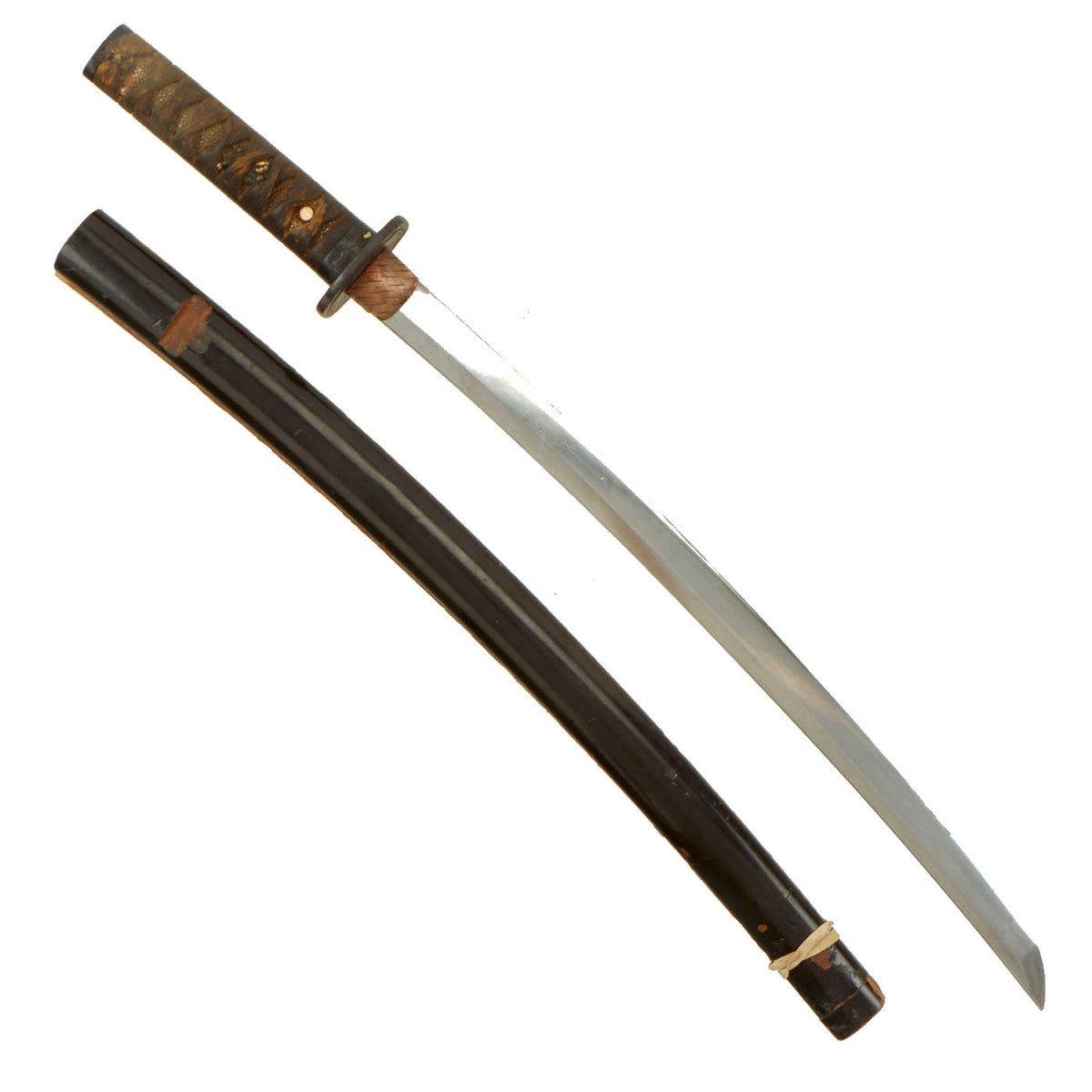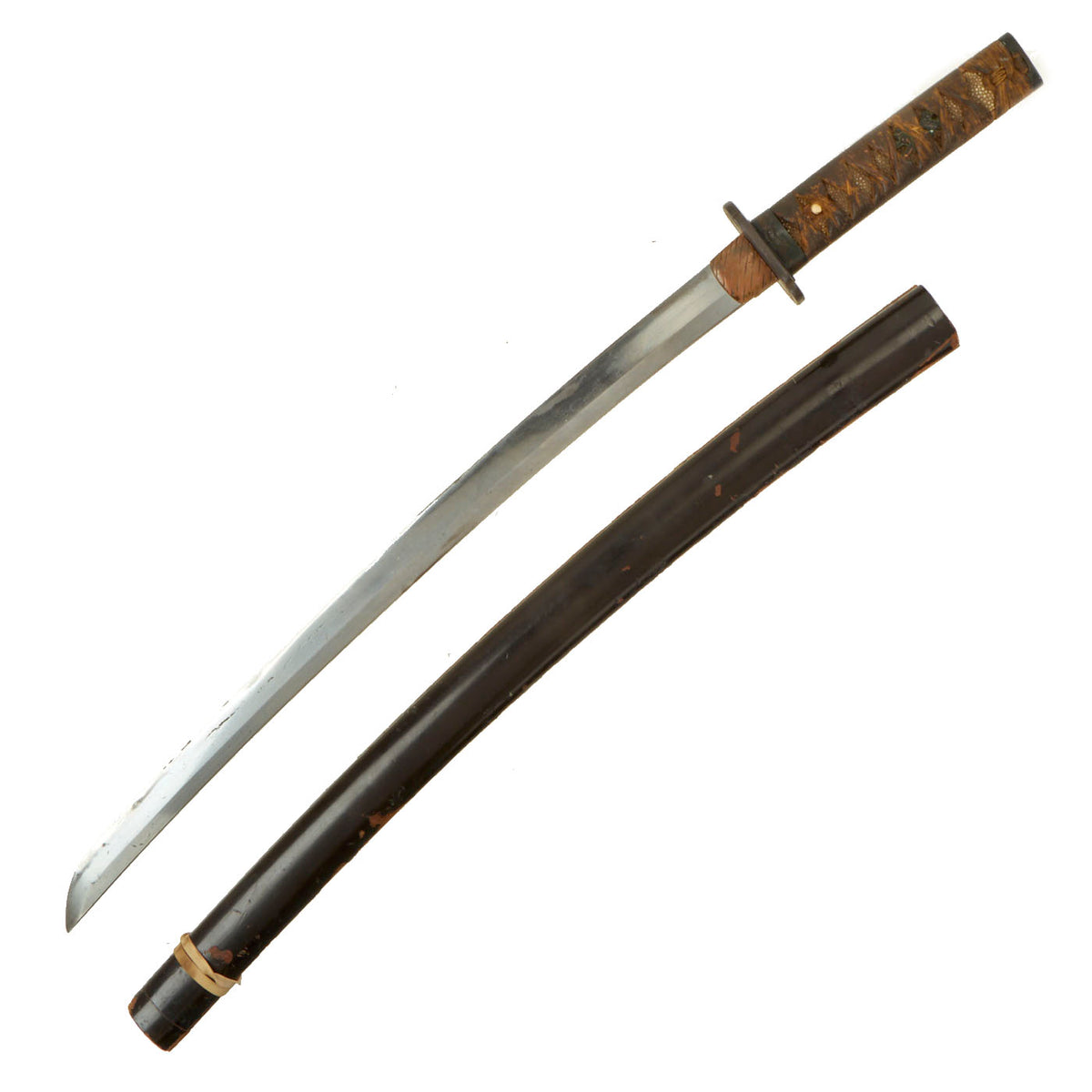Original Edo Period Japanese Wakizashi Short Sword with Handmade Blade & Scabbard in Bring Home Box Original Items
$ 1.595,00 $ 398,75
Original Item: Only One Available. Wakizashi (脇差 “side inserted / companion sword”) is a general term for a sword with an edge between one and two shaku long (30 cm and 60 cm), predominantly made after 1600. Generally it is the short blade that accompanies a katana in the traditional samurai daisho pairing of swords, but may be worn by classes other than the samurai as a single blade, also worn edge up as the katana.
This example dates from the Edo period (江戸時代, Edo jidai) or Tokugawa period (徳川時代, Tokugawa jidai) of Japanese history. This is the period between 1603 and 1867, when Japan was under the rule of the Tokugawa shogunate and the country’s 300 regional daimyo. Due to the age we assume it is from the 18th century or earlier. It is around the longer end of the blade length range, and has a “Shinogi Zukuri” shape, the most common shape used, and the standard for the longer Katana. Some possibly would classify it as an “O-Wakizashi”.
The sword was received in an original wooden bring home box, which measures approximately 37″ x 5″ x 5″. It is from the time before Zip codes were instituted, and definitely looks to be WWII era. Many items were sent home from Japan during the post war occupation. This box indicates it was sent by Mr. & Mrs. J. Allen of South River, NJ, to Mr. Frank Yorkiow of Detroit, MI. The packing inside is exactly what we have seen in other bring back boxes for Japanese swords. We would assume that Yorkiow may have come back via boat or plane, and then had friends ship it to him later. Definitely some great research potential!
This example has most likely been remounted several times, as was common for Japanese blades. This has made the file marks (yasurimi) on the tang faint, and given it a lovely patina. As there is no maker name on the tang, this blade is considered 無名 (mumei), or “anonymous”.
The blade has the following period correct features:
– Folded steel blade (fold lines are evident on the spine and body of the blade)
– hole (mekugi-ana) in the tang is punched and not drilled
– blade has a temper line (hamon), which is faint
– Blade wounds (kizu) or lamination artifacts are present on the blade. Both ware (lamination lines) and fukure (carbon pits) are visible, including some long ones.
The blade of this example is 20 3/4 inches long, and the polish on the blade is worn bright, showing much cleaning and use since the last time it was fully polished. This has made the temper line and other aspects of the blade hard to see. Overall length of this wakizashi is 28 inches.
The hamon (temper line) is still faintly visible in the light, and is of the GUNOME (zig-zag) shape, with activity visible within. There are also KINSUJI and SUNAGASHI visible above the temper line. The tang (nakago) is of the futsu 普通 (regular) style, with a Naagari (asymmetrical rounded) nakago-jiri. There are blade wounds including ware (lamination splits) and fukure (Carbon pits), some of which are quite long.
The sword has a copper Habaki (blade collar), which is typical of the Edo period.
The tsuba (cross guard) is made of iron and is of the Mokko Gata (quince) shape, with only an inner border as ornamentation. There are two Hitsu-ana cut outs on either side of the blade, one for a Kogai hair ornament and one for a Kogatana Knife.
There are is a single seppa, which looks to be a more recent replacement made from hard rubber. The fuchi (collar) for the tsuka (handle) is blacked brass, as is the Kashira (End Cap), and bear matching embossed plant designs. There are two bronze menuki grip ornaments present, which look to be dogs. The stingray (Sa-Me) grip is in good condition, with a lovely aged color. The surrounding complete Ito (cloth binding) shows wear and staining from age and use, but no major damage or tearing.
The sword comes in a a gloss black lacquer wooden scabbard (saya), which unfortunately split in half at some point, and was glued back together poorly. The two halves were not properly aligned, but it could probably be split again and glued properly. The kurikata (knob) is missing as well.
A nice Edo Period O-wakizashi, complete with scabbard and stored in a wonderful bring home box. Ready to research and display!
Specifications:
Blade Length: 20 3/4″
Overall length: 28“
Scabbard Length: 23 1/2″
It has been over one thousand years ago that the art of making swords appeared in Japan. The swordsmiths of the time may not have known it but they were creating a legendary sword. The Samurai sword has seen combat in many battlefields. From the early days of the Samurai warrior to the fierce battles in the South Pacific during WWII.
Each hand-made Japanese blade (日本刀 – Nihonto) is unique because it is forged from multiple pieces of folded steel stock. A tremendous amount of work is dedicated to creating these pieces. They were an instrument of war as much as a beautiful artifact to adorn a room.
The traditional Japanese blade and mountings have grown to be one of the most highly desired military antiques.
Fast Shipping with Professional Packaging
Thanks to our longstanding association with UPS FedEx DHL, and other major international carriers, we are able to provide a range of shipping options. Our warehouse staff is expertly trained and will wrap your products according to our exact and precise specifications. Prior to shipping, your goods will be thoroughly examined and securely secured. We ship to thousands clients each day across multiple countries. This shows how we're dedicated to be the largest retailer on the internet. Warehouses and distribution centres can be located throughout Europe as well as the USA.
Note: Orders with more than one item will be assigned a processing date depending on the item.
Before shipping before shipping, we'll conduct a thorough inspection of the items you have ordered. Today, the majority of orders will be delivered within 48 hours. The delivery time will be between 3-7 days.
Returns
The stock is dynamic and we cannot completely manage it because multiple stakeholders are involved, including our factory and warehouse. So the actual stock may alter at any time. It's possible that you may not receive your order once the order has been made.
Our policy is valid for a period of 30 days. If you don't receive the product within 30 days, we are not able to issue a refund or an exchange.
You can only return an item if it is unused and in the same state as the day you received it. You must have the item in its original packaging.
Related products
Uncategorized
Uncategorized
Armoured Fighting Vehicles of the World: AFVs of World War One (Hardcover Book) New Made Items
Uncategorized
Uncategorized
Uncategorized
Uncategorized
Uncategorized
Uncategorized
Uncategorized
Uncategorized
Uncategorized
Australian WWII Owen MK1 Machine Carbine SMG Custom Fabricated Replica with Sling Original Items
Uncategorized
Uncategorized
Uncategorized
Uncategorized
Uncategorized
Uncategorized












































































